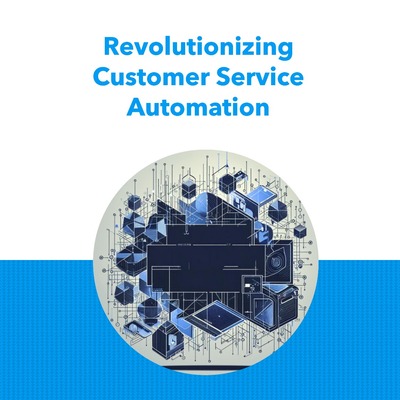What is the next frontier in customer service automation?
Background:
Happy customers are repeat customers. Customer service automation is the key. In the dynamic landscape of business evolution, automation has emerged as the cornerstone of efficiency. It unleashes a multitude of possibilities beyond the familiar realms. This blog delves into the uncharted territories of automation. We seek hidden gems that promise to elevate business strategies to unprecedented heights. Join us on this journey as we uncover untapped potential. Unveil underutilized areas. And connect the dots between overlooked automation opportunities and enhanced business performance.
Uncovering Hidden Gems: Customer Service Automation Opportunities Beyond the Basics
Understanding the untapped potential of automation in business strategy.
Automation has come a long way in revolutionizing customer service, but many businesses are only scratching the surface of its potential. By understanding the broader applications of automation in their overall business strategy, companies can unlock new opportunities for efficiency, productivity, and customer satisfaction. From streamlining internal processes to enhancing customer interactions, automation can be harnessed in various ways to drive business success. Customer service automation is the key.
Highlighting underutilized areas in automation.
While automation has become commonplace in areas like email responses and chatbots, there are still many untapped opportunities to explore. For example, automating data analysis can provide valuable insights for decision-making, automating repetitive tasks can free up employees for more meaningful work, and automating personalized customer interactions can enhance the overall experience. By identifying these underutilized areas, businesses can capitalize on the benefits of automation in new and innovative ways.
Linking overlooked automation opportunities to enhanced business performance.
When businesses uncover and leverage hidden automation opportunities, they can experience significant improvements in their overall performance. By automating tasks that were previously time-consuming and error-prone, companies can streamline their operations, reduce costs, and increase productivity. Moreover, automation can enable businesses to deliver more personalized and efficient customer service, leading to higher customer satisfaction and loyalty.
Presenting case studies on companies successfully harnessing these hidden opportunities.
To illustrate the impact of uncovering hidden automation opportunities, it’s valuable to showcase real-world examples. Case studies of companies that have successfully implemented automation in innovative ways can inspire and provide insights for others. These case studies can highlight the specific challenges faced, the automation solutions implemented, and the resulting benefits achieved. By learning from these success stories, businesses can gain practical knowledge and inspiration for their automation journey.
Redefining ROI: The Power of Holistic Approach in Customer Service, And Hence Customer Service Automation
The role of a holistic approach in reshaping customer service experience.
A holistic approach to customer service automation involves considering the entire customer journey and integrating automation at various touchpoints. Instead of focusing solely on individual interactions, businesses should examine the end-to-end customer experience and identify opportunities to enhance it through automation. By taking a holistic view, companies can ensure consistent and seamless customer service across multiple channels and interactions.
Interviews with industry experts on the best practices.
Investing in a comprehensive and automated customer service experience can yield substantial returns on investment. When customers have positive experiences with a company’s customer service, they are more likely to become repeat customers. This in turn means they are more likely to recommend the business to others. Finally, it increases the chance that they will leave positive reviews. By leveraging automation to deliver personalized, efficient, and effective customer service, businesses can foster customer loyalty, drive sales, and ultimately boost their ROI.
In-depth review of strategies that promote a holistic implementation of automation in customer service.
Implementing automation in customer service requires a well-defined strategy that encompasses various aspects of the business. This includes aligning automation efforts with overall business objectives, selecting the right automation technologies and tools. It also means integrating automation seamlessly with existing systems, and ensuring proper training and support for employees. An in-depth review of these strategies can provide businesses with actionable steps to implement automation effectively and holistically.
Correlation between enriched customer service experience and boosted ROI.
To gain further insights into the best practices for implementing automation in customer service, it’s valuable to hear from industry experts. Conducting interviews with these experts can provide unique perspectives, practical advice, and real-world examples of successful automation implementations. By tapping into the knowledge and experiences of these experts, businesses can refine their automation strategies and increase the likelihood of success.

How To Implement a Winning AI and Automation Strategy 2023
I wrote another blog about implementing a winning AI Automation Strategy...you might find it interesting...
Breaking Boundaries: Overcoming Key Roadblocks in Customer Service Automation Implementation
Listing typical bottlenecks in automation incorporation.
Implementing automation in customer service is not without its challenges. It’s important to identify and understand the typical roadblocks that businesses may encounter. These can include resistance to change from employees, technical limitations, lack of clear automation goals, and the need for significant upfront investment. By listing these bottlenecks, businesses can proactively address them and develop strategies to overcome them.
Exploring robust strategies to overcome these roadblocks.
Overcoming roadblocks in automation implementation requires a proactive and strategic approach. Businesses can explore various strategies.
These could include:
– effective change management
– robust training programs for employees
– partnering with experienced automation providers; and
– conducting thorough testing and evaluation before full-scale implementation.
By adopting these strategies, businesses can minimize disruptions and maximize the chances of successful automation incorporation.
Expert advice on pre-empting potential barriers in the automation journey.
Seeking advice from experts who have navigated the automation journey can provide valuable insights into pre-empting potential barriers. These experts can share their experiences, lessons learned, and recommendations for anticipating and addressing challenges before they arise. By leveraging their expertise, businesses can save time, resources, and potential setbacks in their automation journey.
Analyzing common mistakes businesses make during implementation and tactics to avoid them.
While implementing automation, businesses may unknowingly make common mistakes that can hinder the process.
These mistakes can include:
– inadequate planning and preparation
– overlooking the importance of employee involvement and training
– underestimating the need for ongoing maintenance and updates; and
– failing to set realistic expectations.
Analyzing these common mistakes and providing tactics to avoid them can help businesses navigate the implementation process more effectively. By learning from the experiences of others, businesses can enhance their chances of a smooth and successful automation implementation.
Readying for the Future: Preparing Your Business for the Next Leap in Automation
Outlining a roadmap for businesses to prepare for the future of automation.
As automation continues to advance at a rapid pace, businesses need to develop a roadmap that prepares them for the future. This roadmap should involve a comprehensive assessment of the organization’s current state of automation, identification of areas for improvement, and a clear vision for future automation initiatives. By outlining a roadmap, businesses can ensure they are strategically positioned to embrace emerging technologies and leverage automation advancements effectively.
Showcasing trends that are shaping the automation landscape.
To prepare for the future of automation, businesses must stay informed about the latest trends and developments in the automation landscape. This includes monitoring advancements in artificial intelligence, machine learning, natural language processing, robotics, and other relevant fields. By understanding these trends and their potential impact on customer service automation, businesses can adapt their strategies, invest in the right technologies, and stay ahead of the competition.
Investigating practical steps businesses can take now to leverage future automation advancements.
While it’s crucial to keep an eye on future automation advancements, businesses can also take practical steps today to position themselves for success.
This can involve initiatives such as:
– investing in employee training and upskilling to adapt to changing automation technologies
– fostering a culture of innovation and experimentation, nurturing partnerships with automation vendors and experts; and
– actively seeking customer feedback to identify pain points and automation opportunities.
In taking these proactive steps, businesses can lay a solid foundation for embracing future automation advancements.
Foresight on how customer service automation could evolve and tips on staying ahead of the curve.
Businesses should focus on these three areas:
– outlining a roadmap
– staying informed about automation trends; and
– taking practical steps
to position themselves to thrive in the future of automation.
By being proactive and forward-thinking, they can adapt to evolving customer expectations, leverage emerging technologies, and deliver exceptional customer service experiences through automation.
Key Takeaways:
- Customer service automation is the key.
- From reshaping customer service experiences to overcoming key roadblocks and preparing for the future, the power of automation lies not only in its basics but in the nuanced, strategic applications that often go unnoticed.
- Armed with case studies, expert insights, and a roadmap for the future, businesses now have the tools to redefine their approach to automation.
- As the automation landscape continues to evolve, embracing these hidden gems is not just a strategy—it’s a necessity for those seeking to stay ahead of the curve in the ever-changing business terrain.

